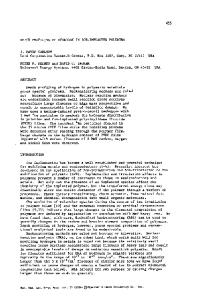Redistribution of Ion Implanted Hydrogen in Polycrystalline Silicon Thin Films
- PDF / 358,340 Bytes
- 7 Pages / 420.48 x 639 pts Page_size
- 99 Downloads / 319 Views
REDISTRIBUTION OF ION IMPLANTED HYDROGEN IN POLYCRYSTALLINE SILICON THIN FILMS RONALD N. LEGGE, and JAMES F. BROWN Motorola Inc. Semiconductor Research and Development Physical Electronics and Packaging Laboratory 5005 East McDowell Road, Phoenix, Az. 85008 ABSTRACT The effect of implanted hydrogen on the resistivity of polycrystalline silicon films has been investigated. The observed reduction in resistivity due to hydrogen is most pronounced for lightly doped films, and is accentuated by a 4500C anneal. An increase in Hall mobility is also observed. The pre-implant resistivity is completely recovered by annealling at 6000C. Diffusion of hydrogen at low temperatures is monitored by local resistivity changes detected with spreading resistance measurements. INTRODUCTION Hydrogen passivation of grain boundaries and point defects in polycrystalline silicon has been studied by many workers for such diverse applications as high density memory circuits [1], and large area solar cells [2]. One major effect of atomic hydrogen on doped poly-Si films is to passivate dangling bonds at grain boundaries and so reduce the barrier height. This manifests itself in a major reduction in resistivity of the film, which we exploit here to measure the effectiveness of a hydrogen passivation process, and to characterize the rapid diffusion of hydrogen at low temperature. Several different techniques have been used to introduce atomic hydrogen into poly-Si in order to optimize this effect on resistivity. In this study we use a non-mass analyzed, high current, low energy implantation process. We also use a masked implant to provide an abrupt hydrogen-no hydrogen junction in the poly-Si. This is used to measure the effect of diffusion of atomic hydrogen by the use of a spreading resistance probe (SRP). Two temperatures were chosen for this diffusion study. The low temperature used was 4500 C. At this temperature the implanted hydrogen appears to be fully activated and redistributed throughout the film thickness. The high temperature used was 6000C, which was chosen because of reports that at this temperature hydrogen rapidly diffuses out of the Si into the gas ambient [3]. This is accompanied by an increase in resistivity back to the pre-hydrogen value. Spreading resistance data taken on bevelled films allow an estimate of this out-diffusion rate to be made. EXPERIMENTAL PROCEDURES The polycrystalline Si films used in this study were prepared by LPCVD at 625650 0 C using SiH 4 onto thermally oxidized p-type Si wafers of 7-17 ohm-cm resistivity. The oxide was MOS quality, 3000 Angstroms thick, and the poly-Si was I B, As, or micrometer in thickness. The undoped films were then ion implanted with P, capped with reactively sputtered silicon nitride at approximately 250 0 C, and then annealled to activate and redistribute the dopant. The Si3N4 was removed and the wafers were quartered. The implantation and anneal conditions that were used are
Mat. Res. Soc. Symp. Proc. Vol. 59. c1986 Materials Research Society
494
summarized in Table I. It
Data Loading...



